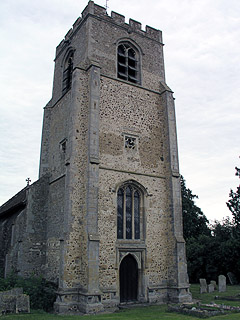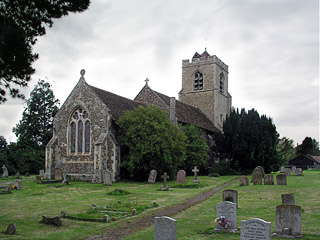St Andrew bears the scars (or would 'cosmetic enhancements' be a more apt metaphor?) of a drastic Victorian restoration in the 1860s. During that period most of the windows were replaced, and the south aisle completely rebuilt. The pointing of the stonework is aggressive, and the east window was put in to replace a bigger medieval predecessor. Now, you'd hardly know that the main structure of the chancel is 13th century.
Just about the only redeeming feature, in my opinion, is the 14th century tower. It's quite tall, with cross-buttresses and a good stair turret on the south face. I particularly liked the air holes in the middle stage - square openings with quatrefoil tracery within. The west doorway and bell-openings are Perpendicular, and there's a nice little pyramid roof covered in slightly uneven tiling and topped with a weathervane.
Unfortunately, St Andrew - in common with most of the churches in the Papworth ministry - is kept locked, and there was no information about keyholders. Feeling rather despondent, we peered in through the windows, and decided we weren't missing much. The nave arcades are quite interesting, in the same design we've seen in several places (such as Harston, for example): lozenge-shaped, with engaged shafts on the broad east-west faces, and thin faces into the nave and aisles which are continuous with the wall above.
I saw a screen, but it looked somewhat drab and Victorian. The font cover was rather nice - a modern one with a handle formed by a pair of fish grinning outwards at the congregation - but that's about all. I don't think we'll be coming back to try again.
St Andrew was locked, without any keyholder information.

